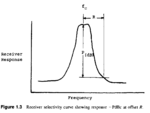the_falcon
Member level 4
hi all,
can you guys make me understand this passage.
Selectivity is the degree of distinction made by the receiver between the desired signal and unwantedsignals. You will find the better the ability of the receiver to reject unwanted signals, the better itsselectivity. The degree of selection is determined by the sharpness of resonance to which the frequency-determining circuits have been engineered and tuned. You usually measure selectivity by taking a seriesof sensitivity readings. As you take the readings, you step the input signal along a band of frequenciesabove and below the circuit resonance of the receiver; for example, 100 kilohertz below to 100 kilohertz above the tuned frequency. As you approach the tuned frequency, the input level required to maintain agiven output level will fall. As you pass the tuned frequency, the required input level will rise. Inputvoltage levels are then compared with frequency. They can be plotted on paper or you might view themon an oscilloscope. They would appear in the form of a response curve. The steepness of the responsecurve at the tuned frequency indicates the selectivity of the receiver.
falcon
can you guys make me understand this passage.
Selectivity is the degree of distinction made by the receiver between the desired signal and unwantedsignals. You will find the better the ability of the receiver to reject unwanted signals, the better itsselectivity. The degree of selection is determined by the sharpness of resonance to which the frequency-determining circuits have been engineered and tuned. You usually measure selectivity by taking a seriesof sensitivity readings. As you take the readings, you step the input signal along a band of frequenciesabove and below the circuit resonance of the receiver; for example, 100 kilohertz below to 100 kilohertz above the tuned frequency. As you approach the tuned frequency, the input level required to maintain agiven output level will fall. As you pass the tuned frequency, the required input level will rise. Inputvoltage levels are then compared with frequency. They can be plotted on paper or you might view themon an oscilloscope. They would appear in the form of a response curve. The steepness of the responsecurve at the tuned frequency indicates the selectivity of the receiver.
falcon
